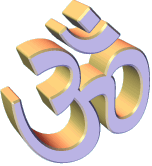Miracles of hinduism
Missing Links-pre-Islamic Arabia
From the British Museum, London, we find this inscription tablet from pre-Islamic Arabia. The crescent and sun on top relate to the Vedic dictum "Yawachchandra Diwakarau," which signifies that the gift mentioned in the inscription should last as long as the sun and moon. This crescent and sun is a Vedic symbol, which still can be seen in use on the flags which adorn the top of the temple of Lord Jagannatha in Jagannatha Puri, as well as on coins in Hindu Nepal. This symbol is in reference to the idea that it is Lord Vishnu who is the source of the light for the sun and the moon. Thus, this symbol which also adorns Islamic flags shows its Vedic influence.
Vedic brass lamp from Saudi Arabia
A typical ancient Vedic brass lamp from Saudi Arabia. Again it is a sign of the Vedic influence that was and still is found in the Middle East and Arabia. Such lamps are still used in India today. Stories of Allauddin, or Aladdin, and His Lamp come from ancient Vedic India, although many give credit to Arabia.
Sarasvati deity from pre-Islamic Saudi Arabia
This image from pre-Islamic Saudi Arabia, displayed at the British Museum, shows goddess Sarasvati riding a swan carrier.
























